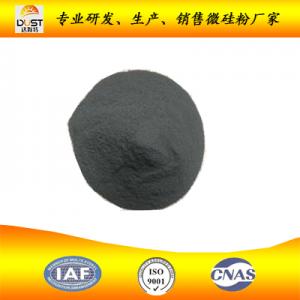Carbon Content Reduction and Fluidity Improvement of Dust Silica Fume
DUSTTM Silica fume is an industrial by-product with fine particle size (avg. 0.1-0.15 μm), good fluidity, and is used in construction, refractory, metallurgy, chemical, etc. In recent years, fluidized bed technology has been used to reduce the carbon content in silica fume. By this technology, under conditions of 700 °C reaction temperature, 3-hour reaction time, and only oxygen, the free carbon content, loss on ignition (LOI) of low-purity silica fume decrease from 1.25% to 0.05%, 3.36% to 0.92%, respectively. And the SiO2 content increases from 81.62% to 85.92%. When changing from oxygen to air environment, the free carbon content, loss on ignition decrease to 0.027%, 0.99%, respectively, and SiO2 content increases to 86.97%.
By further increasing the purity,DUSTTM silica fume can be used in applications such as integrated circuit packaging, fine chemical, advanced ceramics, and epoxy resin for enhancing properties.
The influence of reaction temperature and time on carbon and LOI reduction
Whether it is under oxygen or air environment, free carbon content decreases sharply from 400 to 500 °C, and slightly decreases from 500 to 700 °C, then slightly increases at 800 °C. The LOI stably decreases with the increase of temperature from 400 to 800 °C. To achieve the best carbon reduction effect, the reaction temperature is set to 700 °C under both oxygen and air environments.
From 0.5 – 3.5 h, the free carbon content decreases with the increase of time. While the LOI decreases from 0.5 – 3 h, then increases at 3.5 h. So the reaction time is set to 3 h under both air and oxygen environments.
The carbon reduction effect under the air environment is better than that under the oxygen environment. At 700 °C, with a 3-hour reaction time, the free carbon content, LOI, and SiO2 content under the oxygen environment decrease by 1.20%, 2.44%, increases by 4.3%, respectively. Those under air environment decrease by 1.212%, 2.49%, increases by 5.66%, respectively.
The reasons that the air environment has better results than the oxygen environment are that on the one hand, apart from the reactions between carbon and oxygen, carbon monoxide and oxygen, there are also reactions between carbon and water, carbon monoxide and hydrogen under air environment. On the other hand, the water vapor condenses during air being compressed, then enters the fluidized bed reactor and evaporates at high temperature. From the perspective of reaction rate, the reaction of free carbon and oxygen or water is mainly kinetically controlled.
The fluidity of silica fume
The particle shapes of DUSTTM silica fume are quite different after fluidization. During the process, the particles are rolling and colliding, and the shape and surface of silica fume become spherical and smooth. And the average particle size of silica fume also increases because particles with smaller sizes are taken out by fluidizing air or oxygen.
From the XRD patterns, the high temperature fluidization does not change the amorphous structure of silica fume. And as the SiO2 content increases, the area of the diffuse band also increases.
The angle of repose, degree of compression, velocity of flow are tested to analyze the fluidity of silica fume. Generally, (1) the angle of repose no larger than 40° can meet the fluidity in production; (2) The higher the degree of compression, the poorer the fluidity. When the degree reaches 40% – 50%, silica fume will be difficult to automatically flow out of the reactor; (3) The faster the flow velocity, the better the fluidity. According to the three aspects above, the fluidization process improves the fluidity of DUSTTM silica fume.




